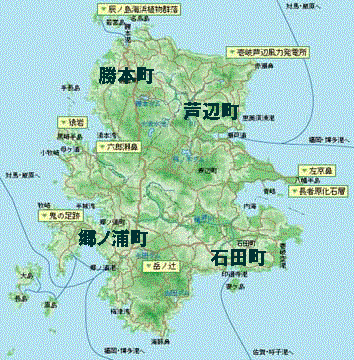It goes without saying that the construction of the Japan-Korea tunnel will have a huge impact on the revitalization of the planned area. Unless the plan is advanced in harmony with the natural environment and the promotion of local industry, it will not be possible to gain support from local people. Although these two islands, Iki and Tsushima, are quite different in area, they have many things in common. Both are said to have been lined up like stepping stones between Japan and Korea, and have long been important points along sea routes, and were counted as one of the Eight Powerful Countries of Saikaido as Iki Province and Tsushima Province, respectively.
To put it simply, the characteristics of Iki and Tsushima are that Iki is ``feminine'' and Tsushima is ``masculine.''
The former has almost no mountains and is gentle, but the latter has extremely steep mountains, and the entire island can be said to be almost a series of mountains. Despite their different topography, both islands share the beauty of their coastlines. The sharp cliffs, intricate bays and coves of various sizes, and the emerald green and cobalt blue ocean contrast with the deep greenery of the island's interior, making it truly beautiful. Both islands were designated as the ``Iki-Tsushima Quasi-National Park'' in 1962, and their scenic beauty welcomes many tourists under the protection of the government. In this way, currently Iki and Tsushima are located within the same Nagasaki Prefecture, and the islands have a population of around 50,000 and are suffering from depopulation, but after the Japan-Korea Tunnel is opened, both islands will be completely different from before. , there is no doubt that they will follow a completely different path of development.
This is because the more you observe the islands and analyze their positioning three-dimensionally, the more you realize that while both islands are different, they each have distinct characteristics. Next, I would like to identify and highlight the problems of each island, extract the benefits and possibilities, and envision a realistic vision for the future of the islands.
 First, let's take a look at Iki Island. Iki consists of four towns. They are Gonoura, Ishida, Ashibe, and Katsumoto. The prefectural branch office is located in Gonoura Town, which is the administrative, cultural, and educational center of the island. The population is 14,600 people and the area is 44 km2. The history of Gonoura dates back to the end of the 15th century, when the Hata clan unified Iki and built castles around Takefu Castle in Takefusui. In addition, Gonoura has Gonoura Onsen (25 degrees, saline spring), and sightseeing spots include Takenotsuji and Saruiwa. From Takenotsuji, a small hill, you can enjoy a good view and see Tsushima in the distance.
First, let's take a look at Iki Island. Iki consists of four towns. They are Gonoura, Ishida, Ashibe, and Katsumoto. The prefectural branch office is located in Gonoura Town, which is the administrative, cultural, and educational center of the island. The population is 14,600 people and the area is 44 km2. The history of Gonoura dates back to the end of the 15th century, when the Hata clan unified Iki and built castles around Takefu Castle in Takefusui. In addition, Gonoura has Gonoura Onsen (25 degrees, saline spring), and sightseeing spots include Takenotsuji and Saruiwa. From Takenotsuji, a small hill, you can enjoy a good view and see Tsushima in the distance.
[Ishida Town] has a population of 5,700 people and an area of 16 km2. There is an airport within the town. Yasuzaemon Matsunaga, the power tycoon, was born in this town, and the Matsunaga Memorial Museum is located near his birthplace. Livestock farming is a popular industry, and Wagyu beef (for meat) is famous. There are also many orchards, and there are good fishing spots along the coast.
[Ashibe Town] was the capital of Japan in ancient times, and famous historical sites include Ankokuji Temple, the old battlefield of the Mongol invasion, and the beautiful Sakyohana coastline, and the large community of Iwadarenezu is designated as a natural monument. The population is 11,200 people and the area is 45 km2.
[Katsumoto Town] has Yunomoto Onsen (51-56 degrees, saline spring), a small fishing port in a beautiful inlet, and is blessed with a resort environment. The population is 8,500 people and the area is 30 km2.
 As mentioned above, the island is clearly divided into four towns, and each town has its own characteristics. The common characteristics of the four towns are that they all have ports and have developed around port towns, and that they also have beautiful coastlines with many people coming in and going out.
As mentioned above, the island is clearly divided into four towns, and each town has its own characteristics. The common characteristics of the four towns are that they all have ports and have developed around port towns, and that they also have beautiful coastlines with many people coming in and going out.
Next, let's extract the problems of the four towns and look at the future of Iki Island.
First, let's list the problems and challenges of the four towns.
① A common problem in all four towns is that the population is flat or slightly decreasing.
Furthermore, the population is aging. The outflow of young people is noticeable, and measures for a U-turn are desperately needed. ② Rather than competing with each other, the four towns are holding each other in check, and the balance among the four towns as a whole is being maintained too much, which seems to be diminishing the image of Iki.
Through the mutual efforts of the four towns, we must aim to improve the overall image of the island. ③The island is extremely flat, and the entire land surface is made up of rolling hills, plains, and forests.
However, the current situation is that no improvements have been made to land use, and there are no main roads, making the area very unclear and difficult to understand. There is an urgent need to create a master plan for the four towns as a whole, and development that is right for the island is desperately needed. When creating a master plan, the construction of a Japan-Korea tunnel will be considered as a prerequisite. ④ A major factor hindering the development of the island is the fact that the economic mother city is Fukuoka City, the administrative mother city is Nagasaki City, and the geographical mother city is Karatsu. There is a contradiction in that it straddles three prefectures: Fukuoka, Nagasaki, and Saga.
Unless this issue is resolved more clearly, the future of the island will become increasingly complex. ⑤We should make use of Iki's current unique industries, such as shochu, Japanese beef, and fruit trees, and introduce new industries that will help improve the island's image.
In addition, the scenic coastline, bays, and small ports with many people coming in and out are ideal for a marine leisure base. We should make better use of these. ⑥ Flat terrain makes development projects relatively easy. The location of this area is suitable for a vacation home, and when it is connected to Kyushu via a tunnel in the future, it could function as a residential area in the outskirts of Fukuoka City. Additionally, sports facilities attached to residential areas, such as tennis courts, golf courses, pools, and soccer fields, may be located at appropriate locations on the island.
The four Iki towns should aim to create a system that allows them to absorb tourists while leveraging their respective characteristics as a resort area with sports facilities and promoting local industry. Gonoura is a resort residential area that takes advantage of hot springs, Ishida is a local industry, Katsumoto is a health, medical and educational facility, and Ashibabe is a sports facility. Of course, it goes without saying that we should aim for the development of an integrated island by relating to each other and cooperating with each other.



[Resort residential area] It is positioned as a residential area on the outskirts of economical mother cities such as Fukuoka City, or as a weekend residential area. In this case, it is essential to have sports facilities, and it is desirable that health facilities and hot spring facilities are also located near the area. The houses are resort-style single-family homes with large gardens measuring an average of 100 tsubo.
[Nursing local industries] In order to promote local industries such as shochu, Japanese beef (beef cattle), and fruit trees, it is possible to establish steak restaurants linked to tourism and brew local wine.
[Attracting and constructing facilities] The climate is warm and there are hot springs, so it is promising to attract silver facilities for an aging society.
These include long-term accommodation facilities, including geriatric care, and housing for the elderly. It is also possible to attract and construct a pollution-free high-tech industrial research institute, a physical fitness test related to a sports facility, and a health facility complete with fitness facilities (such as Kurhaus using hot springs). [Construction of various sports facilities] Currently, there is only one golf course on the island, but considering the topography of the island, it is possible to construct several golf courses. In addition, since the environment is suitable for training camps for athletes, we will expand the grounds currently used for training camps for university sports clubs and provide facilities for senior citizens such as tennis courts, soccer fields, baseball fields, swimming pools, and gateball fields. You may also take this into consideration.
[Marina construction] The coast of the main island is frequented by many people, and there are coves all over the place, and it is blessed with natural marina facilities.
It is possible to construct one or more marinas in each of the four towns. [Establishment of marathon course] The total circumference of the main island is approximately 60 km. A full marathon course of 42.195 km will be built there, allowing the annual "Iki Marathon" to be held as a town-wide, national or international event.
Based on the above, the future themes of the four towns are listed as follows:
1) Each of the four towns has its own characteristics, and
each town has its own charm and individuality.
② Having a unified image of the four towns
A total image of the four towns is needed.
I want an image that gives a clear answer to the question, what kind of island is Iki? ③ Maintaining a balance among the four towns
It is no good if only one town stands out; it is important that all four towns maintain a certain kind of balance.
④ Having the "face" of the four towns
Gonoura Town, the current center of the town, will serve as the main entrance to the town and enhance its function as a center both in name and reality. To this end, it is necessary to provide not only administrative facilities, but also cultural, commercial, information, and educational facilities. Road transportation to the other three towns must also be made smoother.
Official website of
 Iki City Administrative information, event calendar, and tourist attraction information. http://www.city.iki.nagasaki.jp/
Iki City Administrative information, event calendar, and tourist attraction information. http://www.city.iki.nagasaki.jp/
Development and prospects of the Iki/Tsushima region
Overview of the Japan-Korea tunnel